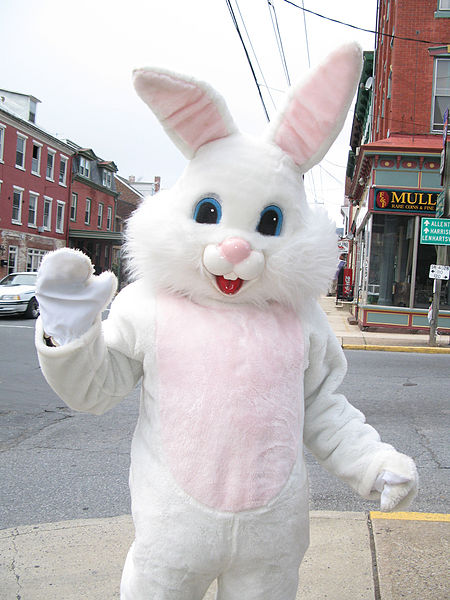 The Easter Bunny is a rabbit character who brings gifts and candy to children on the Easter holiday.
The Easter Bunny is a rabbit character who brings gifts and candy to children on the Easter holiday.Eggs, like rabbits and hares, are fertility symbols of extreme antiquity; since birds lay eggs and rabbits and hares give birth (to large litters) in the early spring, these became symbols of the rising fertility of the earth at the Vernal Equinox.
In English, the word "Easter" etymologically comes from an ancient pagan goddess of the spring named Eostre, related to German Ostara. According to a popular piece of folklore, Eostre once saved a bird whose wings had frozen during the winter by turning it into a rabbit. Because the rabbit had once been a bird, it could still lay eggs, and that rabbit became the modern Easter Bunny.
The precise origin of the custom of coloring eggs is not known, although it too is ancient; Greeks to this day typically dye their Easter eggs red, the color of blood, in recognition of the renewal of life in springtime (and, later, the blood of the sacrificed Christ). Some also use the color green, in honor of the new foliage emerging after the long "dead" time of winter.
German Protestants wanted to retain the Catholic custom of eating colored eggs for Easter, but did not want to introduce their children to the Catholic rite of fasting. Eggs were forbidden to Catholics during the fast of Lent, which was the reason for the abundance of eggs at Easter time.
The idea of an egg-laying bunny came to the United States in the 18th century. German immigrants in the Pennsylvania Dutch area told their children about the "Osterhas" , sometimes spelled out as "Oschter Haws". "Hase" means "hare", not rabbit, and in Northwest European folklore the "Easter Bunny" indeed is a hare, not a rabbit. According to the legend, only good children received gifts of colored eggs in the nests that they made in their caps and bonnets before Easter.
Wikipedia

No comments:
Post a Comment